Hoi An and Hue, both recognized by UNESCO for their historical and cultural significance, offer the casual visitor plenty of postcard perfect views, plus more delicious food than you can handle for just a few dollars. If you have limited time, go to Hoi An, as it's best a place discovered over a few days. Those with five days on the central coast should try to stop at both Hoi An and Hue, as there's tons to see... and even more to eat!
Sights and Activities
All the actual sights in Hoi An require an entrance ticket of 120,000D. This lets you into six sights, and includes your pick of museum, cultural activity, historical house, and monuments. I can't give you much info on whether the ticket is worth it since we decided not to buy it. Travelfish has a good description of the tour that might be helpful, though we didn't feel like we missed out by not purchasing the ticket. In general, when the ticket price rises by 25% in a year, I feel like it's an overpriced ripoff.
Instead of the official "tour," we just walked around town ourselves and admired the architecture of the old buildings. Though most are now restaurants or boutiques, they still retain the design from when they were built in the 15th to 19th centuries. Since receiving the UNESCO designation, Hoi An has essentially stopped modernizing and now capitalizes entirely on its past.
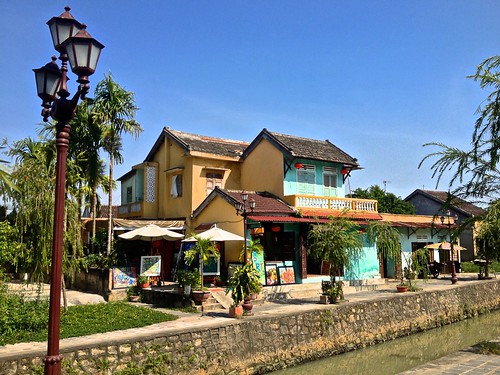
If it's too hot to walk around, rent a bike and head to the beach, 5km away. It's a really pretty ride and the beach is clean, with plenty of shade. We spent our first day there, and were surprised with a pretty crazy sunset at the end.
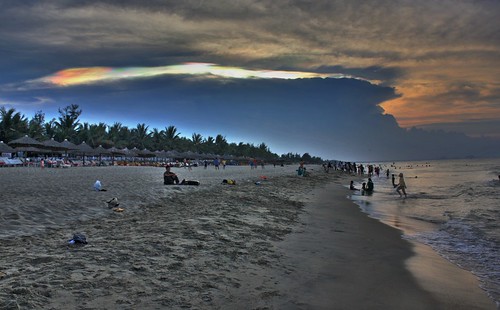
If you have more time to linger, you can also take your bike across the river to Cam Kim island. Take the local ferry across instead of paying for a tourist boat and get lost amidst the rice paddies and boat building shops. Real Vietnam is right here, only 10 minutes away from touristy Hoi An, and it makes for a nice few hours of cycling.
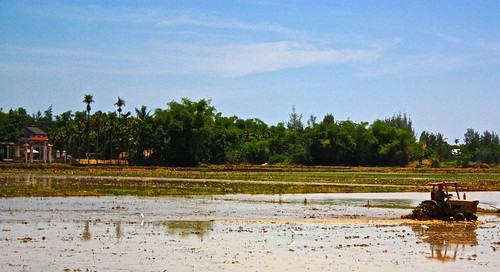
TIP: Avoid the tourist boats and get on the local barge
Bargain your ticket down to 10,000D - MAX!
The other reason tourists flock to Hoi An is for custom-made clothes. The Australians in particular go wild, which makes a ton of sense considering how expensive things there are. If you do want to pick up a few things, the best (and cheapest) place is by the market, since those vendors don't have to pay taxes to the government and hence can charge less for the same quality of goods. Try to pick fabrics unique to the area—silk particularly—and don't order a bunch of clothes in a style you've never worn before. The last thing to consider is time: though some clothes is promised in 24 hours, if you're having anything done that's more expensive or difficult (i.e. a suit), you should expect, and insist on, a few fittings.
TIP: Bargaining is fine when it comes to custom made clothes, but know that if you push too hard, the quality of the work and the materials will suffer
Hue offers a few more "sights" than Hoi An, and sees far fewer tourists. We enjoyed our afternoon stroll around the Citadel grounds, though if you're looking for anything like Beijing's Forbidden City you'll be disappointed. Supposedly at its height, the Citadel here did rival the one in Beijing, but too many bombing campaigns (both by the Vietnamese against the French and the Americans against the Vietnamese) led to wide-scale damage and the loss of several buildings. Here, too, the prices have been raised to 105,000D, which is pretty steep. Still, there are some helpful signs on the grounds and some intact temples through which you can walk.
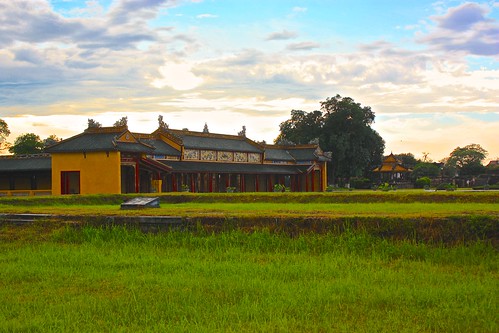
TIP: If you want more info than what's available on the signs, hire a guide
They should cost around $5 for a group. Also, don't confuse the cyclos as real guides... They will drive you around the Citadel, not take you through.
The most interesting thing about Hue is that it's profiting off a history that most people in the country, and the city, want to move past. The Citadel and the Royal Tombs, both UNESCO sites, celebrate a royal lineage from 1802-1945 that operated largely under French guidance and oversight. Since the Vietnamese emperors were really nothing more than puppet kings, the grandiose nature of the tombs and citadel is even more amusing. In fact, for a while after gaining independence, the Vietnamese government let these sites go to the wind; hence the dilapidated conditions after only 200 years.

You can sign up for a bus/boat tour ($8-10) that will take you to several sights, including the Citadel and some of the Royal Tombs. Unfortunately, you have to pay admission for each one, and the costs really add up, as each tomb in 80,000D. Instead, on our first night, we opted for a "sunset cruise" from one of the boat ladies at the end of the bridge. You don't see too much, but we bargained for it to be 30,000D each, which made it a worthwhile excursion.
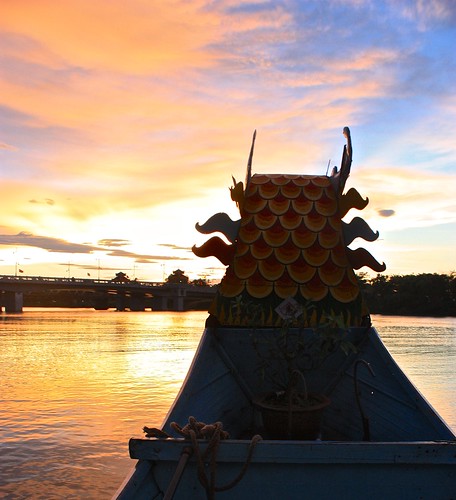
The next day, we considering hiring some motorcycle guides to take us around to the Royal Tombs. They wouldn't budge from $10 each for a few hours, so instead we rented bicycles and headed to the Tu Duc Tomb on our own. It's only a 5km ride, but the bikes suck and there are plenty of hills to make you sweat. Still, the countryside is beautiful, full of vibrant green rice paddies dotted with mausoleums. It seems that everyone got onto the "Royal Tomb" bandwagon, as the cemeteries for the villagers were more impressive than most in the States.
Tu Duc Tomb itself is a nice place to spend a few hours. Most of it is shaded, there's a nice pond, and there are plenty of palaces and tombs to check out, including that of his wife and his adopted son. As with the Citadel, the strangest thing was how little was left of the palace, given that the site was less than 200 years old. There was no bombing here, so general negligence and poor materials are to blame for the dilapidated conditions.
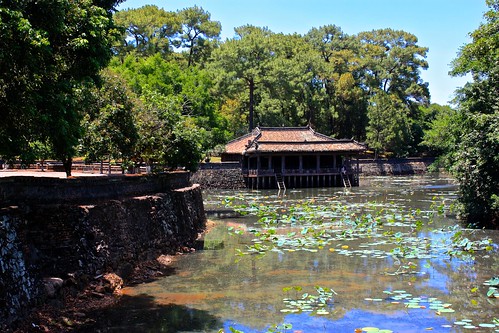
From the Tomb, we took a ride over to Thien Mu Pagoda, which officially has the best views of any temple—ever.
Another full day option in Hue is to take a motorbike tour of the DMZ (Demilitarized Zone). Besides being in beautiful countryside, you'll get to visit some historical sights from the Vietnam/American War as the DMZ marked the dividing line between North and South Vietnam for close to 20 years. If you're a history buff, this is definitely worth it, and we heard from friends that a guide makes it a lot better. If you go this route, shop around for the best price and aim for $17-20/head.
Hotels
Hoi An is pretty pricey as far as budget destinations go, and it's seemingly impossible to spend less than $20 for a decent room. We stayed at Hoang Trinh and paid $23 for a double room. It wasn't the most modern place, but the AC worked and the included breakfast was delicious and varied. They also had one room ready for us when we arrived off the night bus at 7am, which was a big plus.
In Hue, we had a family room at Amigo Hotel for $25. There wasn't much natural light, but the room itself was clean and modern and the included breakfast was delicious. The staff also went above and beyond, giving us free iced tea and fruit plates both when we arrived and after we checked out. Even though we didn't book any tours with them (as they were overpriced), they continued to treat us as valued guests.
Food and Drink
Most people agree that Hoi An has the best food in all of Vietnam. I can tell you that we agree, even though we never really ate at a restaurant. The beauty of this town is that you can spend a few dollars on the street and have the most amazing meals ever.

The banh mi (sandwiches) are better than anywhere else in the country, with thick bread that actually has a crunch. The local specialty of cau lau, sliced pork over thick wheat noodles, is out of this world, at least according to Rob. The banh vac, or "white rose" shrimp dumplings, are delicious, and almost everywhere offers glasses of bia hoi (draft beer) for $0.12-0.50! You really can't go wrong.
The only restaurant we ate in was the iconic Cargo Club on the main street. We split a continental breakfast, which featured the best croissant in SE Asia. That's not saying much, but it was a LOT better than anywhere else. We ate all of our dinners at the stalls that pop up by the river, on the other side of the Japanese Bridge. Entrees ranged from $1-2, and everything was delicious.
The liveliest spot for drinks is Before and Now, which offers "ladies night" specials of free cocktails at exactly 10:15pm. Random, but my gin fizz was really good and came with a fun straw. Our favorite place for drinks, however, wasn't a bar at all, but a boat on the river that at night became a hot spot for travelers. Here you can listen to live music, have great conversation, and have bowls of beer for $0.50!
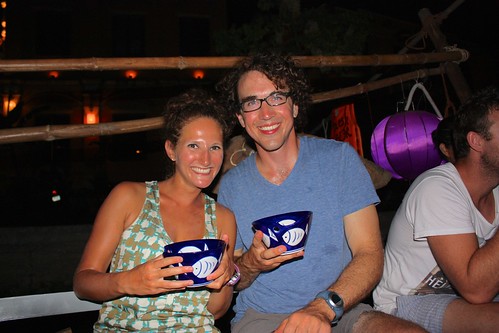
TIP: If you head to the beach, the best and cheapest place for food is Mama Ly's, which is pretty much the last restaurant as you walk down with the ocean on your right
If you eat there, you can leave your bikes and use a lounge chair for free!
Hue also has its specialties, which include its own version of pho and roll-it-yourself spring rolls. We enjoyed the latter twice, at Lac Thien, across the bridge and by the Citadel. At 50,000D, they weren't the cheapest, but the ingredients were fresh and there were enough fillings to make 6-8 huge rolls. There are two identical restaurants by this one, all run by members of the same extended family. Pretty much all of the people who work there are deaf, which makes communication interesting though surprisingly easy.
At nighttime, keep walking past the second bridge until you get to a row of seafood stalls. They all offer the same thing, but some are more willing to bargain. After some haggling, we got 18 huge grilled oysters for the equivalent of $5. I could have eaten there all night!
TIP: Stick to the seafood at the night stalls
The other food is mediocre and overpriced.
In both towns, we enjoyed huge glasses of che, which is a sweet Vietnamese drink made from a number of different (vegetarian) ingredients. The typical glass costs 10,000D and comes with a mixture of sweet beans, taro, and fruit jellies. It's surprisingly refreshing.

TIP: You're supposed to eat your che with a spoon, not drink it out of the glass
You'll know you're doing it wrong if the whole thing ends up on your chin and clothes!
Transport
The bus from Hoi An to Hue cost $3.50 and took 4 hours, a crazy amount of time for so short a distance. Still, it had the nicest rest stop I've ever experienced, complete with an infinity pool and the ocean.
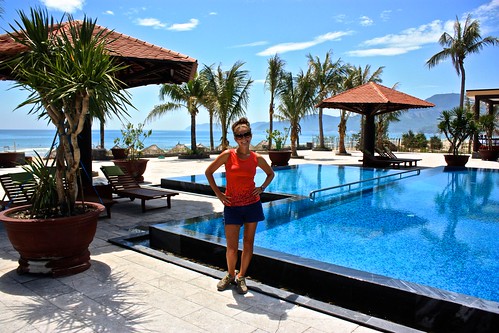
From Hue, we took the night bus to Hanoi. It cost $14 and this time we got our money's worth as there was, indeed, a toilet.
More Hoi An and Hue
Interested in seeing the UNESCO World Heritage towns without paying for a plane ticket? Check out our Hoi An photo tour and Hue photo tour.
Do you have any budget travel tips for Hoi An or Hue? Let us know in the comments!
Comments